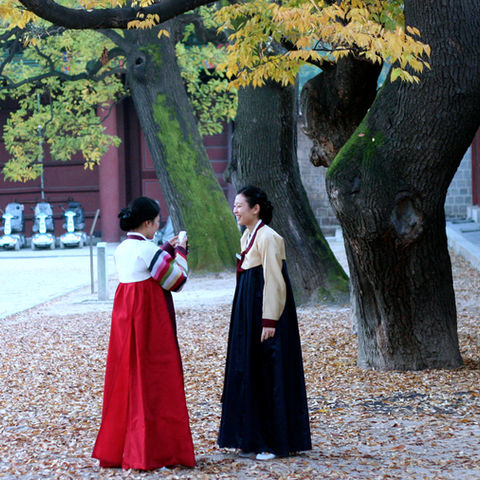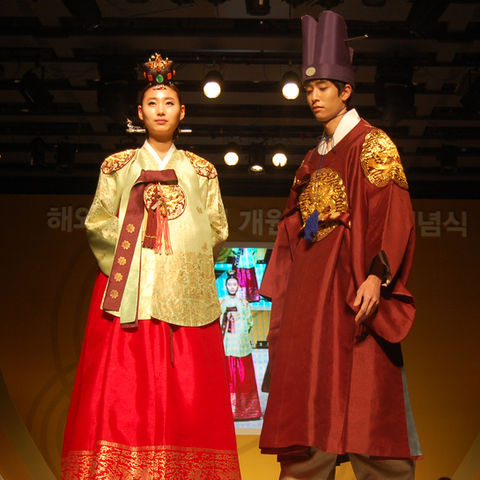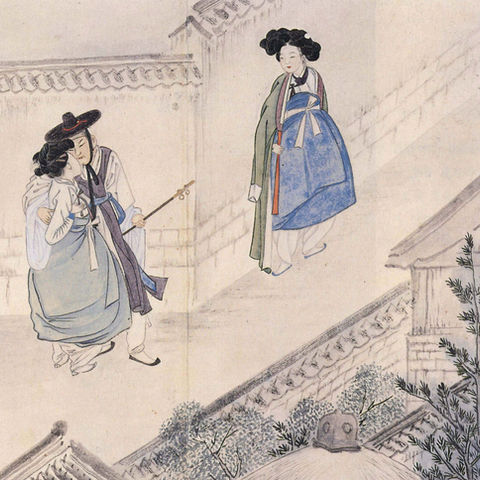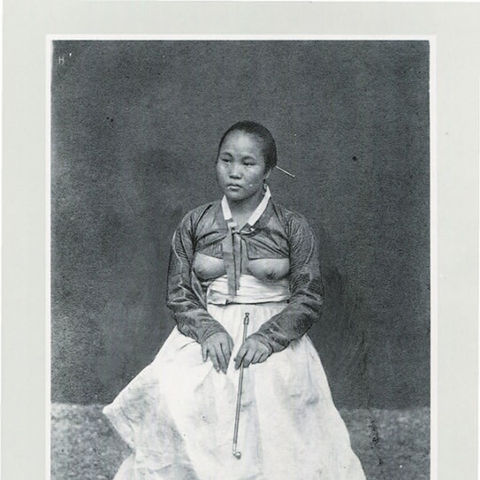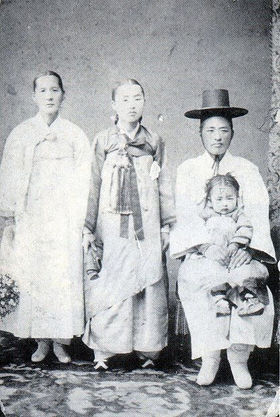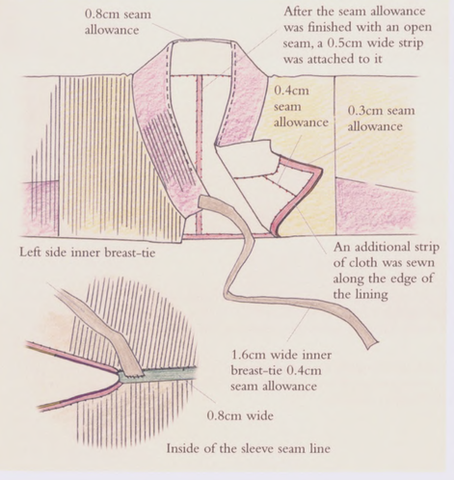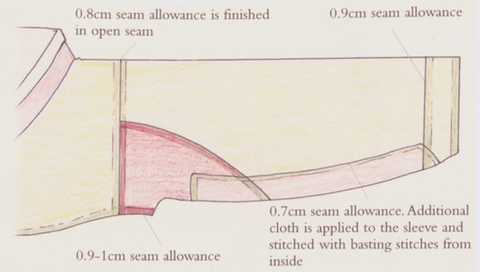
Late Joseon Women's Hanbok
Overview
Origin:
Korea -18th and 19th Century

Hanbok Overview
Hanbok- or traditional Korean dress- is a unique form of costume deeply connected to Korean history and is still worn in the modern day. Although mostly worn for traditional celebrations such as weddings and holidays, the style of hanbok is quickly becoming a universal symbol of Korean beauty and national pride. With its strong worldwide presence growing due to the popularity of Korean film, television, and music, it is easy to see why this traditional dress has persisted into modern times.
Hanbok has a rich history of over 1500 years from the three kingdoms era of Korea to modern day, with the modern design being most influenced by the Joseon dynasty, Korea's longest reigning dynasty from 1392-1897. Even through so many centuries, the hanbok silhouette changed little throughout this time. Dress was seen as an outward expression of social and aesthetic values of the Korean people who's lives were shaped by Confucian philosophies. These philosophies dictated a person's position in society and decided what one could and could not wear.
During the late Joseon dynasty (late 18th and 19th century), the strict principles of Neo-Confucian society began to wane. Jackets became shorter and some skirts were hiked up, showing bloomers. The strong presence of primary colors, flowing lines, and the symbolism found within the designs of the hanbok are important aesthetic values found in Korean art.
As Songhoon Lee said in "Hanbok: Timeless Fashion Tradition," the "hanbok is something more than just everyday clothes. Rather, it should be considered as a cultural artifact that provided a window to Korean identity and cultural heritage" (7)
Related Videos




Related Images

Historical Research

Late Joseon Hanbok Historical Research
The basic styles of Korean dress were essentially established during the 1st-7th century, otherwise known as the three kingdom's period. Since then, the silhouette has changed very little. With a deep connection to Korean history and cultural aesthetics, each aspect of the dress is important and tells the story of the Korean people.
History of the Silhouette
Artifacts from the Three Kingdom period show the early aspects of hanbok, which can be divided into three parts of dress.
The first part is the baji or pants, and jeogori or jackets. During this time, the jackets were long, reaching the hipline, and were tied around the waist. It had a straight neckband and narrow sleeve with trimmed hem and cuffs. These pieces were worn by both men and women.
The second part was the chima or skirt, which was worn by both men and women, and was not a common as it would become in later centuries. It was mostly worn in southern Korea, but women still preferred to were pants over the skirt outside of ceremonial times.
The third division was the po or coat, which was again worn by both men and women over either a jacket and pants or a jacket and skirt. It had a similar shape to the jacket but with wider sleeves. It was mostly worn by the upper class. The costume was finished with a hat that was sometimes decorated with feathers.
According to "Traditional Korean Costume" by lee Kyung Jay, Hong NaYoung, and Chang Sook Hwan, over the next 1000 years four major changes occurred to the Korean parts of dress that lead to the characteristics of traditional hanbok we recognize today. The first occurred during the 7th and 9th centuries when "the Silla kingdom adopted the official China’s Tang dynasty (618—906) as early as AD 649, before it had unified the Three Kingdoms" (9). These styles of dress, including government officials wearing black caps and white coats for everyday wear, showed that Tang and Korean styles existed side by side.
The second came during the Goryeo kingdom (1259-1356) when Korea came under Mongol rule. With over a century of cross-cultural exchange, Mongol influence could be seen in even the king's and upper official's dress who adopted the manner of dress and hairstyles of the Mongol people. "The most conspicuous examples of this influence were a ceremonial cap (jjokduri), and a hair ribbon (doturakdaenggi) worn as wedding attire. A coat with pleats (cheollik), common during the Joseon period, was also introduced during Mongol rule. During this time, hanbok worn by rulers became more colorful and elaborate, while the general populace continued to wear more muted tones with fabrics made of hemp.
The third turning point came as the Mongols withdrew and a new dress system was ordered by King Wu in 1387. This new order demanded Korean officials should follow "the newly established Ming dynasty (1368-1644) that had replaced the Mongol Yuan
dynasty in China. Officials now wore the samo silk hat and the dannyeong coat that were worn in China, while their ranks were distinguished by the materials used in making their belts" (10). The gat, the large hat worn in Korea, also came from this time. Neo-Confucianism was also introduced in China during the Sung and Ming dynasties. This ideology would go on to shape the Joseon dynasty, and have profound effect on hanbok. Cotton was also introduced which changed the way clothes were made.
During the Joseon dynasty, several changes occurred, including "breast-ties and knotted buttons for fastening, and the attachment of a narrow white strip of cloth called a dongjeong, to the collar"(10). However, the largest change came during the mid to late Joseon time period when economic changes brought new wealth to Korea as well as a renaissance in thought called Silhak, or practical learning, and the creation of Hangeul, or the Korean alphabet. By the reigns of KingYoungjo (1724-76) and King Jeongjo (1776-1800) the style of hanbok was established. "The style that now evolved could be said to project a certain ‘dignity’ in men’s costume and ‘modesty’ in women’s, but both these Confucian concepts were sublimated in the aesthetics of dress"(11).
Influence of Neo-Confucianism on Hanbok
The guiding force of the new Joseon dynasty was Neo-Confucianism, which adhered to the principles of simplicity and austerity. This ideology is found in the basic form of the hanbok.
During this time, men sought to project an air of dignity. They refrained from being seen outside without a hat or proper attire. Women too covered their heads with an overcoat when they ventured from their homes. "Men wore many layers of undergarments, including jackets, loose pants and coats, all of which contributed to the wearer’s appearance of dignity and calmness"(11).
Women also wore voluminous layers of skirts and covered their skin to adhere to the principle of modesty. These layers consisted of a pair of baggy pants over three pairs of increasingly smaller pants, worn over a loin cloth. The skirt covered these pants with some upper class women wearing multiple layers of skirts for special occasions. A tighter jacket was worn under the outer jacket. This silhouette created an exaggerated silhouette that concealed the true figure of the woman. Instead the focus was on the aesthetic lines and details of the dress.
Towards the end of the Joseon period, social ethics began to change and more skin was shown. The practice of tying the skirt up to show the bloomers was the height of fashion, and eventually the pants that made up the undergarments were accepted as normal outerwear for women.
Related Videos





Related Images

Construction Practices

Late Joseon Hanbok Construction Practices
Coming Soon!!
Related Videos








Related Images

Literature Links
Traditional Korean Costume

"The first of its kind in English, this spectacular, detailed volume in full color celebrating the richness and variety of traditional Korean garments, ornaments and footwear dating back to the Joseon Dynasty is a treasure. Over 600 drawings and 200 plates, with detailed commentaries and specific measurements, as well as method of production."
Throughout the chapters, the reader can see detailed drawing of where seams should be, the insides of the garments, and images of traditional fabrics. Men's, women's, and children's clothes are highlighted including accessories, shoes, and ornaments. There is also detailed clothing vocabulary to help you build research terminology.
White Hanbok as an Expression of Resistance in Modern Korea
Author:
Bong-Ha Seo
Year: 2014

Abstract:
"All aspects of clothing, including color, are a visible form of expression that carries invisible value. The purpose of this work is to study the expression of resistance in the white Hanbok in modern culture, specifically
after the 1980s. Koreans have traditionally revered white color and enjoyed wearing white clothes. In Korea,
white represents simplicity, asceticism, sadness, resistance against corruption, and the pursuit of innocence.
This paper looks at: (i) the universal and traditional values of the color white, (ii) the significance of traditional
white Korean clothing, (iii) the resistance characteristics of white in traditional Korean clothes, and (iv) the
aesthetic values of white Hanbok. The white Hanbok often connotes resistance when it is worn in modern
Korea. It is worn in folk plays, worn by shamans as a shamanist costume, worn by protestors for anti-establishment movements, and worn by social activists or progressive politicians. The fact that the white Hanbok has
lost its position as an everyday dress in South Korea (instead symbolizing resistance when it is worn) is an
unusual phenomenon. It shows that the white Hanbok, as a type of costume, is being used as a strong means of
expression, following a change in the value of traditional costumes as it take on an expressive function."
Hanbok: Timeless Fashion Tradition
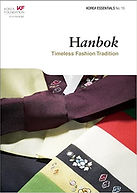
Abstract
"Hanbok embodies many of the social and aesthetic values of the Korean people. In accordance with the emphasis on social harmony found in Confucian philosophy, the choice of hanbok varied depending on one's position in society. Its beautifully flowing lines and harmonious color schemes are important aesthetic values found in Korean art. Hanbok is increasingly emerging into the spotlight following the popularity of Korean television dramas, which are often set in the past, and also through efforts to promote hanbok on the global stage. Renowned fashion designers around the world have taken note of hanbok and have incorporated its elements into their own work. This book will examine the origins, history, and the unique characteristics of hanbok and its contemporary standing"
Our Hanbok Story: Pre-Historic/ Joseon Dynasty/ Modern day
Author:
hyea jiw
Year: 1985
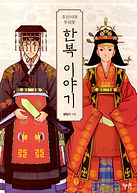
"Our Hanbok Story" is a detailed three volume set of books. Each book contains hundreds of full color rendering of the forms of dress historically worn by the Korean people. Based on research from Korean museums, the author recreated each garment as it would have been worn on a figure. This gives the designer a chance to see how each piece would have been worn on the body, as well as the scale of each piece.
The full set cover 20 centuries starting from prehistoric time and early Korean history. The second volume is fully dedicated to the Joseon dynasty and the forms of dress worn by commoners and royalty alike. The final volume covers from the Joseon dynasty to modern day Korea.
Hopefully a translated version of these books will be available someday, however for the time being these volumes are only available in Korean. I would strongly recommend them for the image references for designers or technicians.


